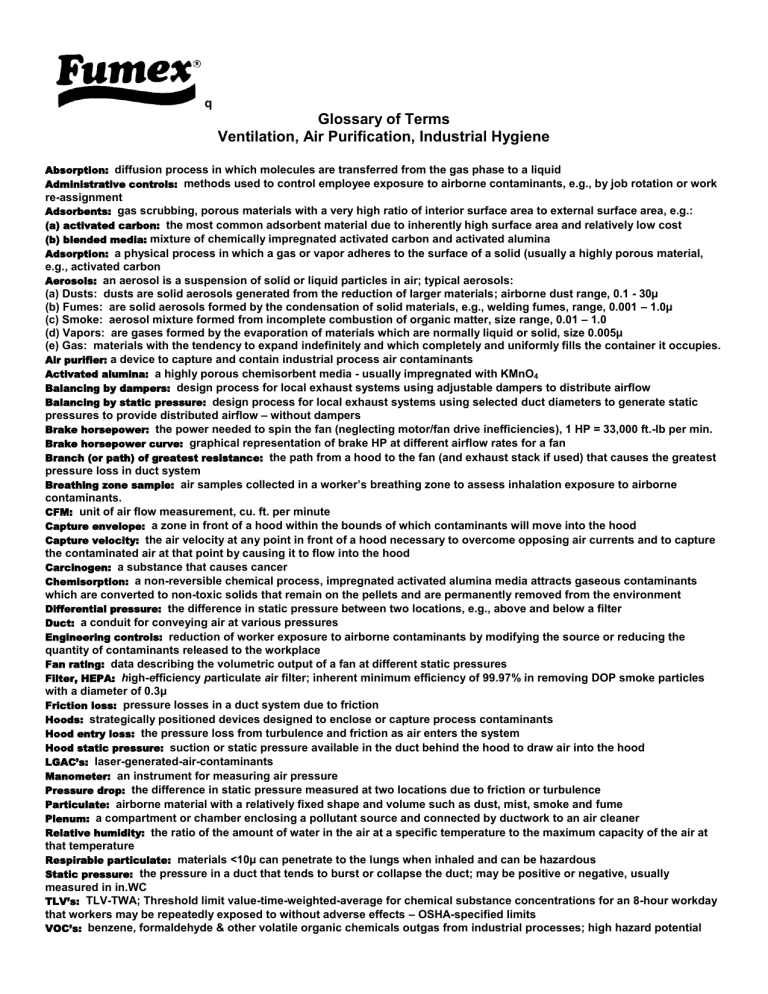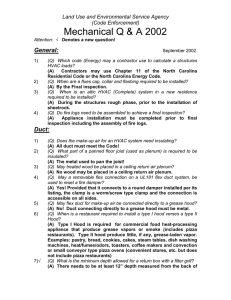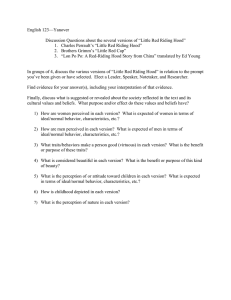Glossary of Terms Ventilation, Air Purification, Industrial Hygiene

q
Glossary of Terms
Ventilation, Air Purification, Industrial Hygiene
Absorption:
diffusion process in which molecules are transferred from the gas phase to a liquid
Administrative controls:
methods used to control employee exposure to airborne contaminants, e.g., by job rotation or work re-assignment
Adsorbents:
gas scrubbing, porous materials with a very high ratio of interior surface area to external surface area, e.g.:
(a) activated carbon:
the most common adsorbent material due to inherently high surface area and relatively low cost
(b) blended media:
mixture of chemically impregnated activated carbon and activated alumina
Adsorption:
a physical process in which a gas or vapor adheres to the surface of a solid (usually a highly porous material, e.g., activated carbon
Aerosols:
an aerosol is a suspension of solid or liquid particles in air; typical aerosols:
(a) Dusts: dusts are solid aerosols generated from the reduction of larger materials; airborne dust range, 0.1 - 30µ
(b) Fumes: are solid aerosols formed by the condensation of solid materials, e.g., welding fumes, range, 0.001
– 1.0µ
(c) Smoke: aerosol mixture formed from incomplete combustion of organic matter, size range, 0.01
– 1.0
(d) Vapors: are gases formed by the evaporation of materials which are normally liquid or solid, size 0.005µ
(e) Gas: materials with the tendency to expand indefinitely and which completely and uniformly fills the container it occupies.
Air purifier:
a device to capture and contain industrial process air contaminants
Activated alumina:
a highly porous chemisorbent media - usually impregnated with KMnO
4
Balancing by dampers:
design process for local exhaust systems using adjustable dampers to distribute airflow
Balancing by static pressure:
design process for local exhaust systems using selected duct diameters to generate static pressures to provide distributed airflow
– without dampers
Brake horsepower:
the power needed to spin the fan (neglecting motor/fan drive inefficiencies), 1 HP = 33,000 ft.-lb per min.
Brake horsepower curve:
graphical representation of brake HP at different airflow rates for a fan
Branch (or path) of greatest resistance:
the path from a hood to the fan (and exhaust stack if used) that causes the greatest pressure loss in duct system
Breathing zone sample: air samples collected in a worker’s breathing zone to assess inhalation exposure to airborne contaminants.
CFM: unit of air flow measurement, cu. ft. per minute
Capture envelope:
a zone in front of a hood within the bounds of which contaminants will move into the hood
Capture velocity:
the air velocity at any point in front of a hood necessary to overcome opposing air currents and to capture the contaminated air at that point by causing it to flow into the hood
Carcinogen:
a substance that causes cancer
Chemisorption:
a non-reversible chemical process, impregnated activated alumina media attracts gaseous contaminants which are converted to non-toxic solids that remain on the pellets and are permanently removed from the environment
Differential pressure:
the difference in static pressure between two locations, e.g., above and below a filter
Duct:
a conduit for conveying air at various pressures
Engineering controls: reduction of worker exposure to airborne contaminants by modifying the source or reducing the quantity of contaminants released to the workplace
Fan rating:
data describing the volumetric output of a fan at different static pressures
Filter, HEPA: h ighe fficiency p articulate a ir filter; inherent minimum efficiency of 99.97% in removing DOP smoke particles with a diameter of 0.3µ
Friction loss:
pressure losses in a duct system due to friction
Hoods:
strategically positioned devices designed to enclose or capture process contaminants
Hood entry loss:
the pressure loss from turbulence and friction as air enters the system
Hood static pressure:
suction or static pressure available in the duct behind the hood to draw air into the hood
LGAC’s:
laser-generated-air-contaminants
Manometer:
an instrument for measuring air pressure
Pressure drop:
the difference in static pressure measured at two locations due to friction or turbulence
Particulate:
airborne material with a relatively fixed shape and volume such as dust, mist, smoke and fume
Plenum:
a compartment or chamber enclosing a pollutant source and connected by ductwork to an air cleaner
Relative humidity:
the ratio of the amount of water in the air at a specific temperature to the maximum capacity of the air at that temperature
Respirable particulate: materials <10µ can penetrate to the lungs when inhaled and can be hazardous
Static pressure: the pressure in a duct that tends to burst or collapse the duct; may be positive or negative, usually measured in in.WC
TLV’s:
TLV-TWA; Threshold limit value-time-weighted-average for chemical substance concentrations for an 8-hour workday that workers may be repeatedly exposed to without adverse effects – OSHA-specified limits
VOC’s:
benzene, formaldehyde & other volatile organic chemicals outgas from industrial processes; high hazard potential



